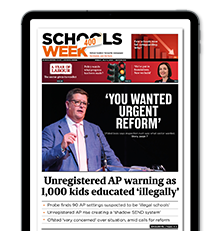Thousands more teachers are leaving the profession as the pandemic’s effect wears off, new figures suggest, with vacancies at their highest level in more than a decade.
Official census data on the school workforce, collected last November and published today, also shows more newly qualified teachers leaving within a year.
It also shows heads and teachers went into the current cost-of-living squeeze – with inflation now at 9 per cent – off the back of just 0.8 per cent and 1.4 per cent annual rises in average pay, respectively.
Kevin Courtney, joint general secretary of teaching union NEU, said figures indicated “serious and deep-rooted teacher recruitment and retention problems remain”.
1. Teacher departures up 12.4 per cent …
The number of teachers leaving last year jumped by 12.4 per cent, with 4,000 more departures in 2020-21 than the previous year. Some 36,262 staff – 8.1 per cent of all teachers – left the state-funded sector.
However, this is still lower than the 9.4 per cent in 2018-19 before the pandemic, with Covid boosting both recruitment and retention.
Workforce expert Jack Worth noted more primary teachers were leaving than secondary for the first time ever. Asian, black, mixed and other ethnic minority background teachers were also more likely to leave than white peers.
To make matters worse, only 11 per cent of those leaving were retiring, whereas a third of those leaving in 2010-11 were retirees.
2. … and uptick again in new teachers leaving
Among newly qualified teachers, the number who left within one year rose from 11.7 per cent in 2020, to 12.5 per cent last year.
Again, this is still below the pre-pandemic levels (it was 14.6 per cent in 2019). Meanwhile, both the two-year and five-year retention rates improved year-on-year.
But Worth notes: “These leaving decisions were taken just after the spring 2021 school closures and before the wider labour market really took off and recovered strongly when restrictions were lifted So no big surprise that numbers aren’t higher, but they may be next year.”
The DfE itself has also predicted a Covid-delayed exodus.
3. Teacher vacancies highest since at least 2010
One signal that the exodus may have begun is in total teacher vacancies, which have jumped 42 per cent in a year to 1,600. It followed small declines over the previous two years.
It means vacancies are now at the highest level since recent records began in 2010-11.
Classroom teacher vacancies hit 1,368 last November, up 45.5 per cent on 2020 and almost four times higher than the 355 vacancies in 2010-11.
Vacancies for “all leadership” posts hit 196, also a record high.
4. Pay growth for teachers outstrips heads’
The average classroom teacher’s salary of £38,982 was only 1.4 per cent higher last November than a year earlier. While heads’ average pay was £74,095, it marked only a 0.8 per cent rise.
“The government plans more real terms cuts to teacher pay, adding to the cuts of around a fifth since 2010,” said NEU joint general secretary Kevin Courtney.
Men continue to generally out-earn women, with secondary heads earning £3,698 more. Significant exceptions are primary classroom teachers, where women earn £655 more on average, and non-head leaders at primaries, special schools and pupil referral units.
But the DfE says average pay levels should not be used to indicate pay awards, partly as factors like better-paid older staff retiring, and being replaced by less well-paid new teachers, could drag down average pay.
5. Secondary class sizes swell by two pupils
The average secondary school teacher taught 16.7 pupils, similar to last year but up from 14.8 in 2010-11. Officials noted rising secondary pupil numbers since 2016.
Primary pupil numbers per teacher remain similar at 20.4 in 2010-11 and 20.6 in 2021-22, though Courtney noted this came in spite of primary pupil numbers falling.
“This adds to the already critical problems caused by excessive workload,” he said.
6. Ethnic diversity increases, slowly
The ethnic diversity of the teaching workforce continued to increase last year, with 14.9 per cent of staff identifying as ethnic minorities, up from 11.2 per cent in 2010-11.
But diversity remains significantly below the national average, with 21.5 per cent of working-age people in England identifying as ethnic minorities.
“White British” teachers remain more likely to lead, making up 15.3 per cent of leaders compared to 8.1 per cent of “Asian or Asian British” teachers.
A recent National Foundation for Educational Research study found ethnic minority candidates are also less likely to be accepted onto teacher training despite “clear and obvious interest” in the profession.
7. Fewer staff sick, but spells off longer
In 2020-21, 45 per cent of teachers took sickness absence, not including isolation or shielding, down significantly on the 54 per cent absence rate in 2018-19. Figures were not collated in 2019-20.
But the average number of days off jumped from just over 4 per cent between 2014 and 2019, to 8.6 days in the last academic year.
















I spent 35 years in the profession and saw it go from a highly motivated, free thinking and enjoyable occupation to one where rigid lesson plans and marking criteria were the expected performance parameters. From being able to create curricular to being told which colour pen to mark with sums up its decline. Pay was always poor given the qualifications and responsibilities but the joy of teaching was the thing, now it’s scrutiny and denigration alongside declining salary. Glad I am out.
I am one of those who are thinking of leaving the profession. Long hours, lack of respect and appreciation, ridiculous amounts of form filling and no social life or work life balance have all gone into making teaching a profession to avoid. I have taught overseas and it seems that only Britain has made teaching intolerable..and if the above is not bad enough we don’t even get a decent salary. I loved teaching but not in the UK …Time for a change.
I have eorked with many schools assisting with their workforce census return each year. I can guarantee those schools have submitted accurate data but prior to me assisting them the data submitted in previous years was not accurate as school staff were largely unaware of how to update salary awards in their software. I would say a large number of schools will still be submitting incorrect salaries making the census figures useless for any accurate comparisons.
I can’t believe that an education site is so badly written.
[…] vacancies overall are at their highest since 2010, thanks to a combination of post-pandemic burnout, stressful workloads and low morale, as well as […]